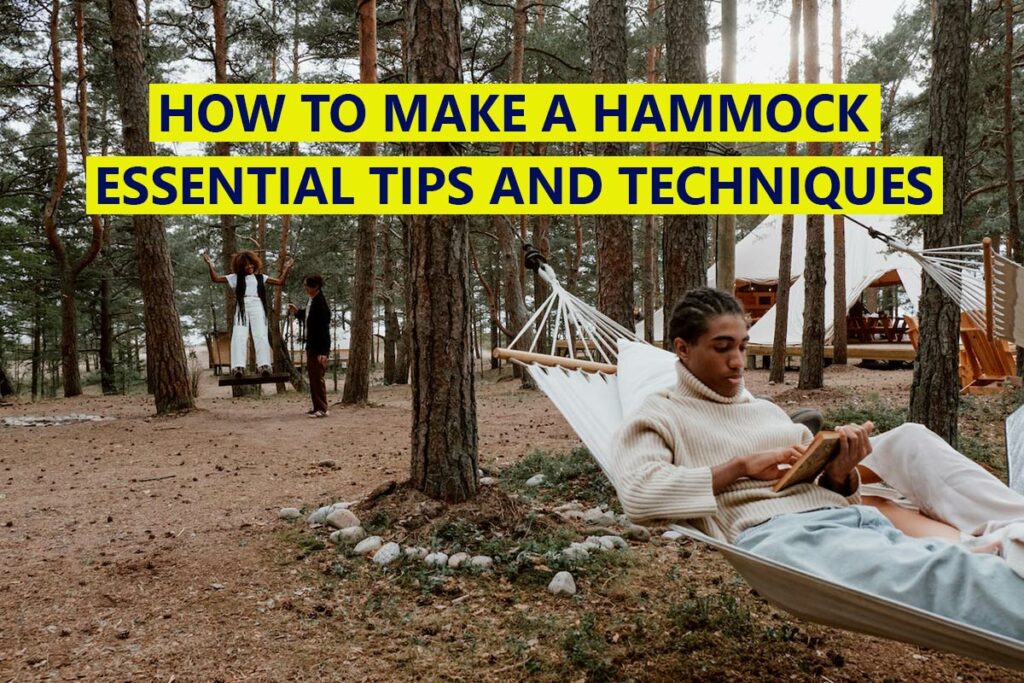A sling made of netting fabric and a rope that can be loosely suspended between two points is called a Hammock. It is used for resting, sleeping, or swinging.
A hammock consists of one or more cloth panels or a woven network stretched with ropes between two firm anchor points, such as a tree.
A hammock is responsible for improving your blood flow and helps take pressure off your joints! They are known to help people relax faster and reduce feelings of stress! They calm the senses with their swinging and rocking motion! When we decide to camp, we prepare a list of things to take with us!
✅Following are the benefits of taking a hammock almost anywhere:
You can camp almost everywhere
A hammock is much easier to set up than a tent. All it needs is two trees at a feasible distance from one another! On the other hand, a tent needs level ground. It also allows you to camp in places a tent simply can’t go, such as a grove of trees or rocky areas!
Hammocks are lighter and easier to carry
Planning on backpacking or hiking? Every ounce adds a weight to your backpack. A hammock is typically much lighter than a tent. This makes the hammock easier to carry!
Another advantage is having more space in your backpack since a hammock does not take up as much room as a tent.
Hammocks are more comfortable than sleeping on the ground
Sleeping on the ground is not always comfortable. The ground can be hard and cold, and rocks can make it difficult to get comfortable. You can sleep comfortably in a hammock and also wake up feeling refreshed.
Ways to make a Hammock
Hammocks are incredibly relaxing, and being suspended in the open air is liberating! Your stress automatically melts away when you are lying in a hammock. This is why so many people love hammocks.
If you want to enjoy the outdoors, you should try experiencing hammock camping. You will first have to learn how to make a hammock.
✅Following are the ways to make a hammock:
Make the spreader bar
The bar that connects the weaving to the fabric bed is the spreader bar. Use a circular saw, hand saw, or cuts and cut one-by-twos to 54. Mark 1’’ with a pencil from one end on the short side, and after that, mark every 2 ½’’.
After clamping down your wood, drill holes at the marks and ensure you are drilling straight up and down. After ending up with 22 holes, sand the holes with a sander.
Weaver
The V-shaped weaving connects the frame of the hammock to the stand. This also helps to anchor the ring to something. You can make use of a thin rope. Ensure that it can at least bear the weight of two people. The packaging of the rope should also include the weight information.
Use two types of knots for weaving: a clew knot and a cow hitch knot. The former is used for creating the weaving, and the latter is used for attaching the rope to the ring.
✅After you start the process with the clew knot:
- Continue the same pattern down.
- Pull each string taut as the weaving starts developing.
- Do not loosen the grip of the knot, and ensure that it is tight by pushing it up.
Take the outermost piece every time.
Cut bed fabric
Measure the bed fabric and cut two seven-long pieces. While cutting, you should make sure that you have a slight convex curve on either end. Measure in 1 ½’’ from the end, and then make a mark on both sides of the fabric.
Sew bed fabric
Buy a double bias tape and ensure it encases the edges of the fabric. Pin the tape around the raw edge, which starts on one of the long sides. Sew together 1/8’’ away from the edge of the bias tape. After doing that, ensure that both layers of fabric are inserted into the bias tape.
Sew around the short side and fold the tape at a diagonal to make it around the corner to the second long side.
Stuff bed
Stuff the batting inside the fabric sleeve and pin the corners in place. If you have any excess of it, trim it off! Sew the final piece of the bias tape, remove the pins, and then fold it over. Folding it over ensures that no raw edges are exposed!
Sew some quilting lines through the bed to ensure the batting stays put. You can even get creative and add buttons or accent threads!
Add grommets
✅For connecting the bed to the spreader bar:
- Make use of grommets.
- Center the spreader bar at the end of the fabric.
- Take the back of one of the grommets.
- Using a pencil, trace the inside circle on the fabric.
- Make a small x-shaped slit and ensure not to overcut it. If you are concerned
about making appropriate-sized holes, buy a grommet hole-punching tool. This tool cuts heavy-duty fabric with the help of a hammer!
Attach a spreader bar
It is crucial to ensure that you thread the rope through the spreader bar to connect all the pieces. Then, through the front side of the grommet, tie the knot to the backside. Use the bottom of the frame as a stopper for holding a spreader bar in place.
Tie each pair of ropes with a tight square knot and pull the weaving tight! Ensure you have three knots as a reference so the tension remains equal.
Add a chain
This might seem a little tedious, but it is easy. Add a quick link for attaching 12’’ of chain to the hammock ring and the eye hook on the stand.
Final words
We all like to take a break from our daily routine and indulge in something fun and exciting! Making a hammock is one of the greatest hacks, as it helps you learn the crude tools of survival!
⭐You also save a lot of money when you make your hammock. Give it a try!




GIPHY App Key not set. Please check settings